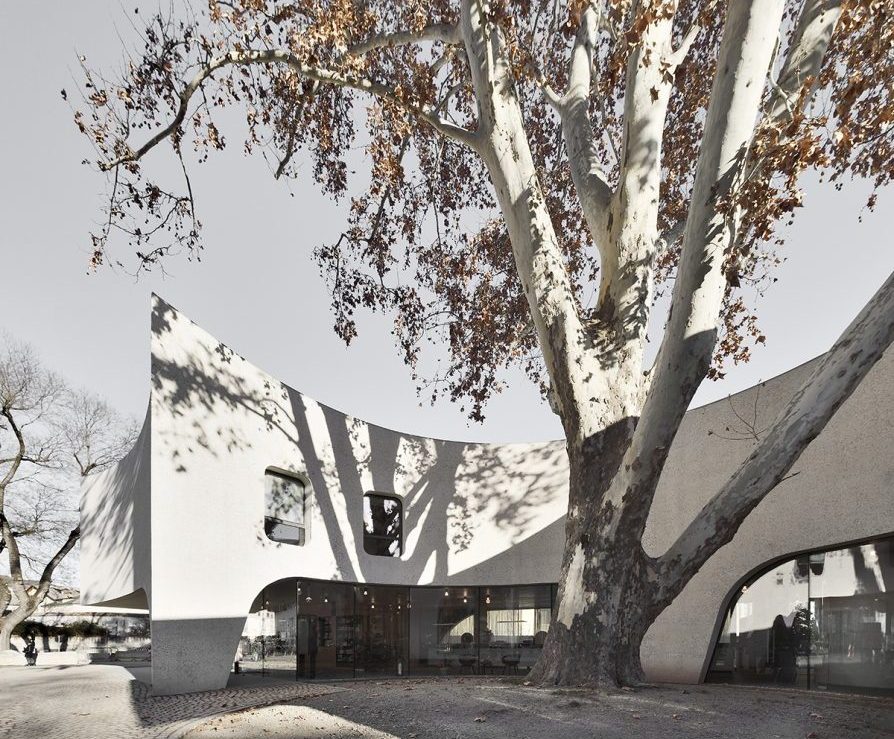The TreeHugger in Italy
A bold concrete building by MoDusArchitects wraps public space with sinuous curves forming an inseparable connection between nature and edifice.

 Italian architecture firm MoDusArchitects designs TreeHugger, the new Tourist Information Office building of the city of Bressanone (Bolzano, Italy), after being the winning entry of an international competition held in 2016.
Italian architecture firm MoDusArchitects designs TreeHugger, the new Tourist Information Office building of the city of Bressanone (Bolzano, Italy), after being the winning entry of an international competition held in 2016.
Located just outside the historical center of the South Tyrolean city, adjacent to the Bishop’s Palace of Bressanone, the eye-catching concrete building takes on the qualities of airiness and levity in alignment with the site’s antecedent structures, which were dedicated to the welcoming of visitors, with their respective features of slender columns, deep loggias, and delicate overhangs.
The firm ModDus Architects was formed in 2000 by Sandy Attia (Cairo, 1974) and Matteo Scagnol (Trieste, 1968) in 2000. The studio distinguishes itself within the international architectural panorama by the bold and heterogeneous body of work that intertwines the founding partners’ two different formative and cultural backgrounds.

 “The building raises its body on tiptoe and frees up the ground level to give the space below over to the city as a public space. New visual connections are made, not only to the main building of the Bishop’s Palace but also to the ancillary Chinese and Japanese pavilions that mark the corners of the Palace gardens. The exotic, sinuous curves of the corner pavilions are re-interpreted in the building which transforms into a new gateway for the city of Bressanone,” says the architects’.
“The building raises its body on tiptoe and frees up the ground level to give the space below over to the city as a public space. New visual connections are made, not only to the main building of the Bishop’s Palace but also to the ancillary Chinese and Japanese pavilions that mark the corners of the Palace gardens. The exotic, sinuous curves of the corner pavilions are re-interpreted in the building which transforms into a new gateway for the city of Bressanone,” says the architects’.
The site is characterized by an existing monumental tree that governs the design. TreeHugger twists and turns around the center to form an inseparable connection between nature and edifice. The visual and tactile qualities of the roughhewn walls of the bush-hammered concrete and the scaly bark of the plane-tree mimic one another in their juxtaposition.

 With the tree trunk as the fulcrum, five arched spans release the building from the ground, accompanying the tree upwards to draw an open frame around the tree’s crown. In order to achieve the seamless, vertical surface of the outer concrete shell, the full height of the walls was cast from one flow and in successive sections to form a continuous 9-meter-high ring, within which the concrete plates were then poured.
With the tree trunk as the fulcrum, five arched spans release the building from the ground, accompanying the tree upwards to draw an open frame around the tree’s crown. In order to achieve the seamless, vertical surface of the outer concrete shell, the full height of the walls was cast from one flow and in successive sections to form a continuous 9-meter-high ring, within which the concrete plates were then poured.

 The curvature of the walls, together with the floor slabs form a collaborative composition in which the form, the structure, and the building facades become one.
The curvature of the walls, together with the floor slabs form a collaborative composition in which the form, the structure, and the building facades become one.
The building is almost entirely glazed on the ground floor, which houses the public spaces and info booths, to allow maximum transparency and permeability. The entrance is clearly marked by the inset windows and the large overhang that cantilevers out towards the new square. The upper floor, housing the administrative offices, is closed and enigmatic in the sequence of its convex surfaces.
With its welcoming curves balanced by the decisive concrete tectonic, TreeHugger strikes up a conversation with its historical context while organically attracting passersby and visitors like a magnet devoted to the sharing of local culture.
Since its inception, MoDusArchitects addresses multiple topics, scales, and programs – from infrastructure to school buildings – and pursues a design process that holds steadfast the relationship between ideas and buildings. The projects are careful studies of the places and contexts within which they are situated to produce surprising architectural vocabularies that combine an approach that is both intuitive and grounded in the tectonics of the architectural discipline.
Project: TreeHugger (Tourist Information Office)
Location: Bressanone (Bolzano, Italy)
Architect: MoDusArchitects (Sandy Attia, Matteo Scagnol)
Project team: Irene Braito, Filippo Pesavento
Structural engineer: Luca Bragagna
Client: Bressanone Tourist Association
Competition: 2016
Design phase: 2017—2018
Completion: September 2019
GFA: 430 sqm
Contractor: Unionbau
Site works: Goller Bögl
Electrical installations: Elektro Josef Graber
Thermo-hydraulic installations: Pezzei
Stone and ceramic flooring: Bernardi & Figli
Carpet flooring: SAXL Bodenbeläge
Glass facade and windows: Huber Hannes
Subflooring and plasterwork: Winkler-Verputz
Drywall and painting: Cimadom Décor
Insulation and plasterboard works: Cimadom Décor
Doors (interiors): Aster Holzbau
Lift: Kronlift
Furniture: Jungmann, Trias
Millwork, custom finishings and furniture: Barth
Interior partitions and furniture: Tischlerei Goller – Anders Gmbh
Sheet metal: Stampfl Bauspenglerei
Custom metal: Ellecosta Metallbau
Multimedia: ACS
Electrical installation: Elektro Josef Graber
Sanitation: Pezzei
Heating, AC, ventilation: Pezzei
Façade concrete supplier: Beton Eisack
Façade bushhammering subcontractor: Designtrend
Roof sealing: Stampfl Bauspenglerei
Insulation and plasterboard products: Stiferite S, Stiferite GTE, Naturaliabau Intello
Wooden doors: Barth
Glass doors: Vetroin
Window profiles: Schüco
Lighting groundfloor ceiling: Viabizzuno n55
Flooring (ground floor): local porphyry
Flooring (first floor): moquette, Fabromont Kugelgarn
Acoustic insulation: Filzfabrik Fulda Lanisor




















